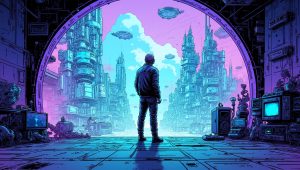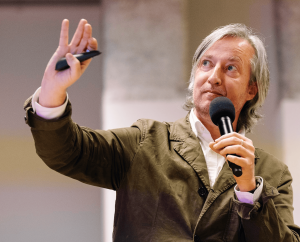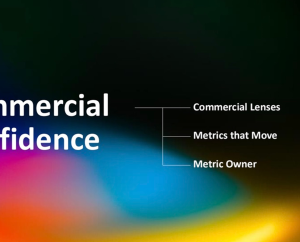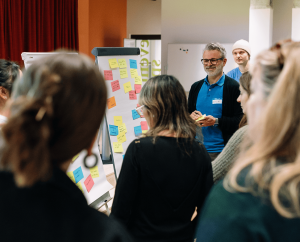Setting the Scene
It’s 8:42 a.m. and you’re walking through the city when your phone pings. The app’s soft voice reminds you to slow your pace—your cortisol levels are spiking. You pause, and the interface shifts: a quiet route through the park, an ambient soundtrack tuned to your current stress profile, and a suggestion to reschedule your 9 a.m. meeting—your team’s bio-data indicates no one’s in the zone yet. You smile. It all just works.
“Hey, wanna go grab a coffee?” your colleague’s voice cuts through. You look up, and realize you’re already at your desk, deep in a Figma file. The app you’re imagining doesn’t exist…yet.
But for a moment, your brain didn’t know that.
In that brief mental detour, your mind performed a dazzling trick. It constructed a future memory using the same machinery it uses to recall your childhood bedroom or what you ate for lunch yesterday. The line between memory and imagination is blurred at best, erased at most.
This is not fantasy. This is neuroscience.
And for designers, understanding how imagination works might just be the most critical tool we have.
How the Brain Builds Futures
Let’s start with a quiet revolution in cognitive science: when we imagine the future, our brains light up the same regions used to remember the past. This includes the hippocampus, long celebrated as the vault of memory, which also helps construct immersive, 3D environments in the mind. Alongside it, the medial prefrontal cortex tracks our goals and updates them as circumstances change, making both regions just as vital for projecting into the future as they are for recalling the past. What’s striking is that this network doesn’t distinguish much between a real memory and a vivid fantasy. Whether you’re remembering a summer afternoon ten years ago or fantasizing about a future career in lunar architecture, your brain is using the same neurological pathways. This “common core network” of the brain is the neurological equivalent of a time machine, with no regard for the direction of travel.
The phenomenon is called “mental time travel.” First described by Endel Tulving in the 1980s, it refers to our brain’s ability to simulate experiences not just from the past, but also potential futures. It’s how we mentally rehearse a difficult conversation before having it, or envision the ripple effects of a design choice not yet made. In that sense, fantasy is not just a creative detour—it’s a cognitive function we depend on to plan, prepare, and ultimately shape our lives.
In short: your brain doesn’t just store memories—it prototypes futures.
This overlapping neural architecture explains why both remembering and imagining feel so vivid, so emotionally charged. They’re not separate processes. They’re two sides of the same cognitive coin.

Why It Matters for Designers
Designers are professional future-makers. Whether crafting an interface, a service, or a speculative world, we routinely call on imagination to model what could be. This work is not decorative; it’s neurological.
Design is one of the rare professions where imagination is both method and output. We don’t just visualize futures—we materialize them. And that act, as it turns out, closely mirrors how our brains naturally simulate reality.
Understanding the psychology of imagination gives us insight into why some designs resonate deeply—why a prototype can feel real, why a speculative artifact can haunt or inspire. It also helps us understand how people engage with the futures we create. If we want others to believe in what we envision, we need to know how belief is cognitively constructed.

The Science of Simulation
Simulation is at the core of this ability. When you imagine yourself doing something—say, riding a bike down a Martian street—your brain activates motor, sensory, and emotional systems almost as if you were physically doing it. This isn’t mere daydreaming; it’s embodied cognition.
What’s more, studies show that these simulations help with actual performance, decision-making, and emotional regulation. Imagining a future doesn’t just prepare us for it—it helps shape our response when it arrives.
This is where design and neuroscience meet. Speculative design, for instance, operates in the simulation space: it lets people “try on” future possibilities through narratives, prototypes, or immersive experiences. The more vivid and embodied the simulation, the more believable—and impactful—it becomes.
In other words, when we design for imagination, we’re designing for cognition.

Training the Imaginative Muscle
If imagination is a skill, then it can be trained—and designers are in a prime position to strengthen this mental muscle. Research suggests that “episodic future thinking” (EFT)—the act of vividly imagining specific future scenarios—can be improved with practice.
So how do we cultivate this ability, both in ourselves and in others?
- Create detail-rich simulations: The more specific the imagined future, the more real it feels. This applies to storytelling, visuals, and interactive experiences.
- Engage the senses: Sensory details ground abstract ideas in lived experience. What does the future smell like? Sound like? Feel like underfoot?
- Anchor to emotion: Emotional resonance helps encode imagined futures into memory, making them feel personal and urgent.
- Build for co-creation: Design tools, frameworks, and scenarios that invite others into the imaginative space. The future becomes more believable when people help build it.
Designers are not just storytellers. We are simulation architects.

Imagination as Influence
This brings us to perhaps the most vital implication of all: if imagination and memory share the same brain systems, then imagination becomes a form of influence. When we imagine a future vividly, we create a memory of something that hasn’t happened yet. And that memory can guide behavior.
This is powerful. It means that designers don’t just reflect the world—we help pre-experience it. And when those experiences are hopeful, inclusive, and grounded in possibility, they shift what people believe is achievable.
In a time when dystopias dominate the cultural imagination, it is a radical act to design utopias—plausible, desirable, actionable futures that invite engagement instead of despair.
Imagination, then, is not escapism. It’s rehearsal.

Steps Forward: Designing With the Brain in Mind
As the meaning of design evolves, so must our understanding of its foundations. The psychology of imagination offers a compelling framework for this evolution. It reinforces what many designers have always sensed: that what we envision shapes what we create, and what we create shapes what we become.
In a world desperate for new narratives, designers are not just decorators of the future—we are its early storytellers. Its sensory engineers. Its memory-makers.
And that work begins not in a lab or a boardroom, but in the brain.
So next time you close your eyes and imagine what’s next—whether it’s a floating city, a healing technology, or a new kind of social contract—remember: you’re not dreaming. You’re designing.
How do you train your imagination—and what future are you rehearsing for?
Sources and Further Reading
- Endel Tulving – “Memory and Consciousness” (1985). Cognitive psychologist who introduced the concept of mental time travel, describing how the brain simulates both past and future experiences using similar neural systems.
- Daniel L. Schacter & Donna Rose Addis – “Remembering the Past to Imagine the Future: The Prospective Brain” (Nature Reviews Neuroscience, 2007). A foundational paper that outlines the brain’s “common core network” involved in both memory and future simulation.
Read via NIH - Demis Hassabis & Eleanor A. Maguire – “Deconstructing Episodic Simulation and Future Thinking” (Philosophical Transactions of the Royal Society B). Explores how the hippocampus supports the construction of imagined future events.
Read via Royal Society - Emily Anthes – “Where Imagination Lives in Your Brain” (Scientific American). A science communication piece highlighting how the brain engages motor and emotional systems during imaginative processes.
Read via Scientific American
All visuals in the piece are created by Hanna Norlin.
***
If you want more Hanna Norlin, then come see her speak at Design Matters 25 in Copenhagen this June. Or if you can’t wait – check out her platforms:
Website: https://hyperscapes.one/
LinkedIn: https://www.linkedin.com/in/hannanorlin/
Mastodon: https://mastodon.social/@hannanorlin










